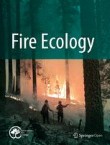Fire Ecology is the official journal of the Association for Fire Ecology.
Shaded fuel breaks create wildfire-resilient forest stands: lessons from a long-term study in the Sierra Nevada
In California’s mixed-conifer forests, fuel reduction treatments can successfully reduce fire severity, bolster forest resilience, and make lasting changes in forest structure. However, current understanding o...
